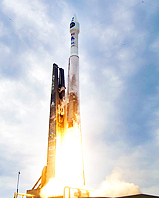Engineering
 |
|
The Atlas V lifts off from the launch pad on June 18, 2009. (NASA) |
Cool science sometimes hides the importance of engineering. This section does the opposite. It shows how cool engineering enables the science done with LRO and CRaTER.
This section describes rocket technology that sent LRO to the Moon, communication technology that enables scientists to receive CRaTER data, CRaTER's cosmic ray detectors, and CRaTER's tissue simulant. Finally, this section shows how scientists and engineers tested CRaTER and LRO to make sure they were ready for a trip to the Moon.
1. Flying to the Moon
On June 18, 2009, a rocket lifted off from a launch pad at Cape Canaveral in Florida. The rocket was a stack of an Atlas V rocket ("V" is the Roman numeral for "5") at the bottom and a smaller Centaur rocket on top. On top of the Centaur were the Lunar Reconnaissance Orbiter (LRO) and the Lunar Crater Observation and Sensing Satellite (LCROSS) spacecraft.
The combination of two rockets and the two spacecraft was almost 60 m (200 ft) tall. That’s the height of a twenty-story building! When fully fueled, it had a mass of almost 350,000 kg (750,000 lb). That is the same as about 200 cars! By itself, LRO has a mass of over 1,800 kg (4,000 lbs) and is about the size of a small car.
At liftoff, only the Atlas V rocket fired. Its engine mixed kerosene and liquid oxygen. The oxygen was cooled to temperatures below -183 °C (-297 °F) to keep it in liquid state!
After the stack had flown above most of Earth's atmosphere, the Atlas V detached from the bottom of the stack. This left the two spacecraft connected to the Centaur rocket.
Then the Centaur fired. Its fuels are liquid hydrogen and liquid oxygen. After a few minutes, the Centaur stopped firing. LRO separated from LCROSS and the Centaur and continued to the Moon.
On its trip to the Moon, LRO had an average speed of 3,200 kph (2,000 mph)--faster than a bullet. It flew the 384,000 km (239,000 miles) to the Moon in 5 days!
To give you a sense of LRO's speed, pretend that you could drive a car to the Moon (in reality there's nothing to drive on). If you drove in a car at about 95 kph (60 mph), you would need 165 days--over 5 months--to reach the Moon! LRO arrived in only 5 days!
 |
“Of course, that’s not as fast as we cosmic rays are. But if LRO and CRaTER are so far away, how do scientists on Earth receive their data? Go to 2. Receiving CRaTER Data.” |
